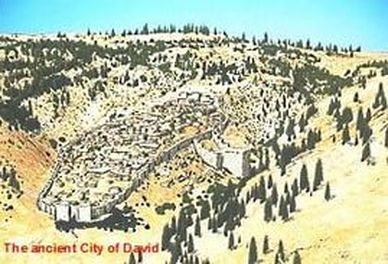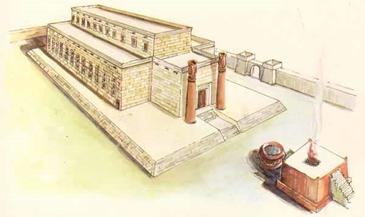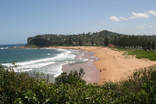|
Also... don't miss the Temple & People Blog Page for interesting current and archived Posts on these subjects.

The Temple in the middle of Jerusalem!
Follow these important clues which more than suggest the location of Jerusalem's Temple in Ezekiel's day and later in the days of restoration and the prophet Zechariah. 1: In Ezekiel 9 the prophet sees God's plan to clean up Jerusalem. Ministers of judgment are deployed to mark out the righteous and destroy those who have corrupted the city. In verse 4 they are instructed to 'go through the middle of the city' marking those who are corrupt. The slayers are to follow to strike the offenders. But note where they are to begin; God says, 'begin at my sanctuary.' Those marked as corrupt were clearly within the city and the judgment was to begin at the very centerpiece of the city--the temple. 2: Another of Ezekiel's visions is that of the glory of the LORD abandoning the temple. It is in chapter 11 where in verse 23 he sees that 'the glory of the LORD went up from the middle of the city and stood on the mountain to the east' (Mt of Olives). The glory of God dwelt in His house, the temple and it was from here in the middle of the city that the glory ascended . 3: A day came after the Babylonian exile when the glory of God returned. Zechariah writes of it as God says, 'I will return to Zion and dwell in the middle of Jerusalem and Jerusalem shall be called the City of Truth, the Mountain of the LORD of hosts, The Holy Mountain' (see Zechariah 8:3). Clearly the temple was in the middle of the city--God in the midst of His people, not on some northern extension removed from it. 4: Psalm 122 is about Jerusalem as the City of God, the holy city where the 'Testimony of Israel' resides. The Testimony (Hebrew EDUTH) is the Law of Moses within the ark of the covenant around which the nation gathered to worship and honour God. Clearly this psalm was written after the building of Solomon's temple, but, importantly, places it within the boundaries of the city (see for example, v.7 'within your walls'). The words translated 'compact together' in verse 3 mean 'of a piece' or 'all joined together'. Temple and township were an inseparable entity. The temple was not remote from the township, some 200 metres to its north! Read the captivating Biblical record of THE PLACE; The locality set apart by God from the days of Eden. Available in print now from Wipf and Stock Publishers by following this link: THE PLACE by Ian Heard THE PLACE available from the Publisher HERE Or as E-Book HERE Visit THE PLACE on Facebook Good news! THE PLACE is again available. Follow the links above With Jerusalem now being recognized by the United States as the capital of Israel what do you know about the true site of Jerusalem’s temples? They were never on so-called Temple Mount. Then, where? They were in the old City of David where there was ‘living water’ from the Spring Gihon. There must be living water at the Temple for it to properly represent the presence of God.
Read ‘THE PLACE HaMakom; where Jerusalem’s temples stood’ https://wipfandstock.com/the-place.html |

Going 'up' to the temple (It's always 'up' to the temple). Cambridge and Oxford students always 'go up' to their respective schools. Here the word 'up' has nothing to do with geography or altitude. It refers rather, to the status accorded learning at these fabled institutes of 'higher' education. To be expelled from these centers of learning was to be 'sent down.' In like manner, the temple for Jewish people was always 'up'. In 2 Chronicles 5:2 ff. the Levites took the ark out of the City of David and 'up to the temple'--because the temple is always 'up'. This does not mean, as some conclude, that the Temple was remote from the City of David and up the hill. Solomon brought the ark and the furnishings 'out of' the secular, unsanctified environment of the City of David and up to their separated and holy environment within the temple. In any case, the temple had steps leading up into it that the Levites did indeed have to ascend. The same status can be seen throughout scripture: in Jesus' parable in Luke 18:10 the two men 'went up to the temple to pray' and in Acts 3:1 'Peter and John were going up to the temple at the time of prayer'. Jesus was crucified near the Temple (The Place)! A literal and accurate translation (eg. see Darby) of John 19:20 reads, ‘this title therefore many of the Jews read, for the place of the city where Jesus was crucified was near; and it was written in Hebrew, Greek and Latin’ (John 19:20) What does John mean by 'the place of the city'? The Place was the ancient 'nickname' for the location of the House of God--the temple. So John means 'the temple of the city where Jesus was crucified, was near.' We must understand this as an explanation for why Pilate wrote the inscription in three languages. The preposition ‘for’ means a reason; and the reason was that Pilate desired Jews from every background and diaspora, gathered at and around the Temple for Passover, to read and understand. And... this is not the only occasion where John employs the Temple's 'nickname'. You may see it used also by the Samaritan woman in John 4:20 where she says, 'you Jews say that in (within) Jerusalem is the place where one should worship.' Then also in John 11:48 after the fuss about Lazarus, the Pharisees fret that the Romans will (literal translation) 'come and take away from us both the place and the nation.' See much more at my Temple Blog
|
LocationBeautiful Newport Beach,
Sydney, AUSTRALIA |
Marilyn Sams - author of The Jerusalem Temple Mount Myth: Ian Heard’s book adds a unique ....aspect to the growing movement of people accepting the City of David location for the temples in Jerusalem. His perspective .....brings many insightful possibilities to the table. Especially moving are his heartfelt expressions of faith in and love for the prophets and the Savior of the world'. |
